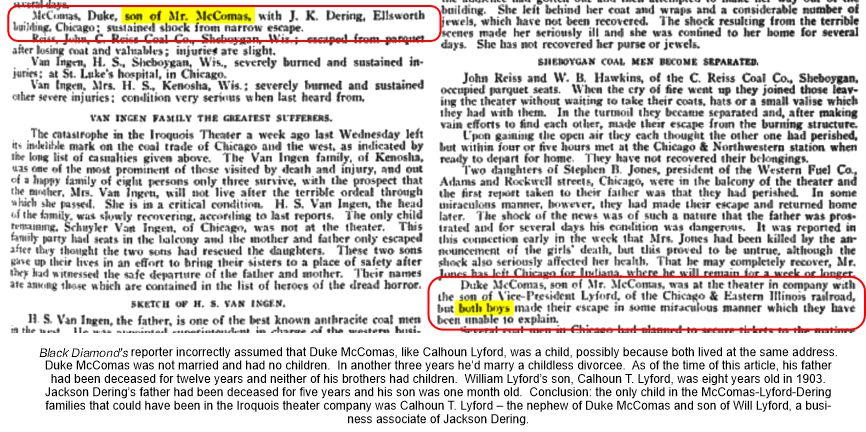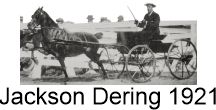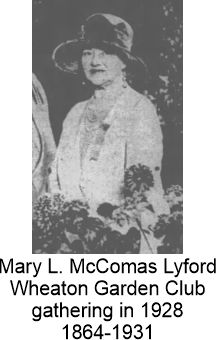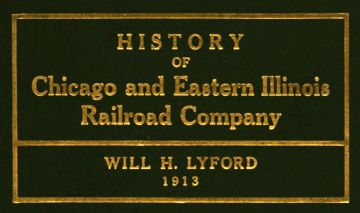|
Nearly six hundred people lost their lives in
Chicago on December 30, 1903. Among the eleven-hundred
survivors of the Iroquois Theater fire
was a party of
two or three businessmen and an eight-year-old
child. With a bit of sleuthing and
conjecture this page offers information
about Jackson Dering, Duke McComas,
William Lyford and Lyford's son, Calhoun
Lyford. (The conjecture part is in
the inclusion of Will Lyford.)
Nothing was reported about the location
of their seats or their escape from the
theater but given their wealth and
survival it is likely they had seats on
the first floor where there were few
fatalities.
Only evidence inaccurate and confused
The presence of any of these people at
Mr. Bluebeard was not mentioned in
daily newspapers. It was published
in
a pair of scrambled references in the January 9, 1903
issue the Black Diamond
(1885–1922),▼1 a trade magazine of the
coal industry.

Fox Lake and the Chicago & Eastern Illinois Railroad (C&EI) Connection
Lyford and Dering were
on a similar footing in terms of
occupation and wealth but McComas was not
and published references putting
any combination of the men together were
infrequent. In May, 1902 at
Washington Park in Chicago the men
played amateur baseball on a sandlot
team named "Ping," made up of Chicago
businessmen in the coal industry. Other than that,
there were fewer than a half dozen
newspaper stories referencing two or
three of the men, most involving
activities at Fox Lake. Will Lyford turned out to be the
common denominator: he was married to
Mary McComas, Duke's only sister — a
socialite known for hosting parties with
hundreds of guests, even a thousand on
one occasion. Mary Lee McComas Lyford was a force to
be reckoned with, I suspect, possessing a drive
similar to Jackson Dering's. In addition to her
hosting huge parties and balls, she founded the
Wheaton Garden Club and the Woman's Athletic
Club in Chicago and prior to marriage
co-founded the public library in her
hometown, Nebraska City, NE.▼2
Lyford and Dering connected as fellow
yachtsmen at Fox Lake▼3 and on business
activities involving coal and the
C&EI Railroad.
Dering was a major coal shipper and mine
owner who purchased dozens of Indiana
and Illinois coal mines, many of them
from the
railroad. The numerous business
transactions between Dering's company
and the C&EI railroad necessitated Lyford's
participation as the railroad's attorney. Duke McComas attended his sister's social events and
so did Dering, but I found
no references to Duke and Dering's
involvement together in clubs or activities
other than those hosted by the Lyfords, nothing to indicate that Duke McComas and
Dering were friendly enough to plan a
theater party that did not include Will
Lyford. Duke McComas may have
joined his brother-in-law and nephew for
an afternoon theater outing, or may have
treated his nephew,
and Dering might have joined the party
on the spur of the moment.
Gregarious by nature, Dering might have met them by happenstance in
the Iroquois lobby, and/or on the street
outside after the fire.
Jackson Dering's office was a single
room with a desk in the fourteen-story
Ellsworth building at 355 Dearborn St.
south of the Loop, a one-mile walk down
Dearborn from the Iroquois Theater. The
Ellsworth Building was later named the
Terminal Building and in 1909 the
address changed to 537 S. Dearborn.
|
|
|
Jackson Kemper Dering (1870–1925)
Jackson Dering was president of Dering Coal,
a wholesale coal and mining company founded in
1888, headquartered in Chicago. In one of his
obituaries he was described as having a cheery
disposition. In tracking his
activities I saw suggestions that he also had a zest for life and
an adventuresome spirit.
He was one of
three children born to Frederick and
Ellen True Dering, named for an Episcopal bishop
who was an old friend of his family.
He married Edith A. Stouffer in 1896 and they
had one child, Jackson Kemper Dering Jr.
(1903–1950). The boy was one-month old at
the time of the Iroquois Theater fire. Jackson
Sr.'s brother, Charles Dering, was also in
Chicago's coal industry.
While building a large coal mining operation
Jackson fell in love with sailing, then with farming,
raising hogs, cattle and horses. In a July 1910
article in the monthly newspaper,
Berkshire
World and Cornbelt Stockman, he attributed
his enjoyment of breeding to his warm
recollections of farming as a boy in Darlington,
WI. He had become a hog and corn buyer for a
business there at age sixteen. His
introduction to coal came when he joined his
brother's retail coal concern in Chicago at age eighteen.

Wealth afforded the Dering family luxury
homes and international travel. They summered at Fox Lake and
rented a home in the city during the winter
months. In Aug 1903 Dering advertised
to find a furnished nine-room rental on the
south side north of 48th St from October 15 to
May 1. In later years he advertised for a second
maid to go with the family for the summer at Fox
Lake.
In 1905 Jackson Dering's company purchased fifteen coal mines
in Indiana and Illinois adjacent to
the C&EI Railroad and the following year merged with Indiana
Consolidated Coal Company, Brazil Block Coal, and Burnwell Coal.
Eight Danville, IL mines of Kelly Coal were
added in 1908, including twenty thousand
acres of land. That's two years of his
mining acquisitions, a pace
continued until at least 1913
when the company failed.
Jackson K. Dering was an achiever. In 1919
he went to Mexico to help refinance United Sugar
Companies and became an officer in the company.
In 1922 he helped reorganize the Mexico &
Pacific Railway and became an officer in the
company. He bought farmland on a lake and when
he wasn't winning yachting competitions was
building herds and became an officer in related
clubs and associations for horses, hogs and
cows. He was an officer of the bank in Lake
Villa, a member of the Chicago Club, Union
League Club, Chicago Athletic Association,
Chicago Yacht Club, Fox Lake Yacht Club, Mid-day
Club, and South Shore Country Club.
Duke Simpson McComas / MacComas (1868–1932)
In 1900 Duke and his brothers, Eugene and Rufus, lived with
their widowed mother at 4847 Kimbark Avenue
in Chicago, next door to their sister, Mary
McComas Lyford, and her family. (Will Lyford
purchased the property in 1898. When sold
in 1906 the Kimbark property brought $40,000 — inflation adj. $1.4 million).
Duke was one of three children born to
Rufus and Elizabeth Simpson McComas of Nebraska.
In 1906 he married divorcee Ella Mersman Hoblit.
They did not have children.
The McComas' later acquired a summer cottage at Fox Lake and
his brother Eugene McComas became president and treasurer of the Dering coal company.
Jackson Dering and his wife attended Eugene's
wedding.
Duke sold stocks and
bonds for a time around 1910, then returned to
coal. In general he kept a low profile.
|

|
William
"Will" Hartford Lyford (1858–1934)
William Lyford was one of six children born to
Oliver and Lovinia Norris Lyford, both of Maine.
He graduated from Colby College in his hometown, Waterville, Maine,
and followed his father into the C&EI Railroad
where he spent most of his fifty-five-year
career as general counsel and vice president. He married Mary Lee McComas
(1861–1931) in 1886, with whom he had two
children, Gertrude Wells Lyford and Calhoun
Theodore Lyford. from Colby College in his hometown, Waterville, Maine,
and followed his father into the C&EI Railroad
where he spent most of his fifty-five-year
career as general counsel and vice president. He married Mary Lee McComas
(1861–1931) in 1886, with whom he had two
children, Gertrude Wells Lyford and Calhoun
Theodore Lyford.
Mary was ill the
last two years of her life but eight months
before her death she and Will were able to
travel to Scotland to visit their daughter
Gertrude, wife of Edwin Boyd. Two days
after Mary's death, Gertrude gave birth to
her third daughter.
After Mary's death,
at age seventy-four, Will did the most impulsive
thing in his life, maybe, by marrying his late
brother-in-law's fifty-two-year-old widow, Saidee F. Drown McComas, widow of Eugene McComas.
The
C&EI Railroad was a consolidation of four
railroads, including the former C&IC "Coal
Road." In 1913 Will wrote a booklet
about the C&EI to that point,
History of Chicago and Eastern Illinois Railroad
Company. It includes references to a
complex labyrinth of ownership between the
railroad and mining companies, including Dering
Coal.

Lyford, Texas was named after Will Lyford.
Calhoun Theodore Lyford (1895–1952)
Calhoun graduated from Yale in 1917,
where he sang tenor in the Glee Club and golfed
in the Hotchkiss Club. He enlisted before even
leaving Connecticut. (Me thinks Mary would
have killed him had he done it under her nose in
Chicago.) At age twenty-one, standing 5'7" and
weighing 155 pounds, Calhoun joined the quartermaster corps.
His responses on on the 1917 Military Census
reported that he could ride a horse and handle a
team of horses, drive an automobile and a
motorcycle, but did not understand telegraphy or
steam engines. He was a good swimmer, could
handle a power or sailboat, and had a bit of
experience with marine engines, but no
experience with coastal navigation.
He survived World War I in Europe, came home
and married Helen Hildegarde
Ames in 1927.▼4 He worked
as an engineer for a public utility company in
the 1930s and in the 1940s and 1950s as a salesman for a
commercial solvent company in Nassau, NY
They had no children.
Calhoun may have been named for his father's law
partner,
William J. Calhoun who became a
distinguished adviser for three U.S. presidents,
McKinley, Roosevelt and Taft, on affairs in
Cuba, Venezuela and China. However,
there was a distant Lyford relative, Minnie Van
Buren, who married a man named Winfield Calhoun.
|
|
Discrepancies and addendum
One research bump to trip over is that William
H. Lyford's daughter, Gertrude
Lyford, married a man named Boyd, and another
woman in Illinois named Lyford married a man
named Boyd and had a son named Dr. William H.
Lyford.
1.
In 1908 Black Diamond ran an interview with
Jackson Dering in which he explained his strong
pro-consolidation views and analysis of coal
mining practices in Indiana and Illinois.
2. Duke's and Mary's father, Rufus McComas,
for many years co-owned and operated sternwheel ferries on
the Missouri River in Nebraska — the
Lizzy Campbell and the James F.
Joy. The Lizzy could carry
thirty teams of horses but the more powerful
Joy was added when railroads reached
Nebraska City; it ferried forty railroad cars on
is first day in service and within a few months
its daily transports were twice that. The
link above is to a delightful article by Verlyn
Mayer on the Steamboat Museum site. It
contains many more tidbits about Nebraska City,
NE steamboats in the 1870s. The Lizzy Campbell was
wrecked by ice in 1883 and reportedly is still
at the bottom of the Missouri River.
3.
Part of the Chain O'Lakes region, Fox Lake is
fifty+ miles north of Chicago in the northeast
corner of Illinois. It became
easier for Chicagoans to reach the area after
the Chicago, Milwaukee, and St. Paul (CM&SP) known as the "Milwaukee Road" (1847–1986)
established a depot at Nippersink Point (later
named Fox Lake) in 1900, a ninety-minute ride
from the Chicago. Within six years Fox Lake
village boomed from a winter population fewer than
four hundred to a summer population estimated at
twenty thousand. The Dering and Lyford families had cottages on the north shore.
Will Lyford had first visited Fox Lake during
the summer of 1895. A nice fish catch
motivated him to purchase a cat boat sailboat,
the Princess, and before the year was out
he was winning races on the lake. The family's
first home there was named "Brightwood
Cottage," later replaced by "Serenado
Cottage." He soon purchased the Starling and
the Gadfly and became an important
figure at the Fox Lake Yacht Club, co-founding
the organization in 1896, serving as its
president and an enthusiastic participant in its
weekly sailing races.
Jackson Dering was also an avid member of the Fox Lake Yacht club and
regularly competed with Lyford in Class B sailboat
races.
Lyford's Flying Fox won
the club's annual trophy in 1903, and Dering won the
honor in 1906 with his
Keewaydin. Dering also owned a
stern paddle wheel named "Roamer&"
of a type that was used to maneuver shallow streams
feeding the Fox River. (Web tromping tells me
that the Fox River is
not navigable from one end to the other
but the early 1900s paddle wheels were used to
carry passengers from train depots to lakes
within Chain O'Lakes. (I can't help
thinking of the scene in Titanic when Rose and
her family boarded with enough travel trunks to
fill the bed of a Silverado. A rowboat
wouldn't have been up to transporting a family,
its servants, and summer belongings..)
The Derings had arrived at Fox Lake in 1901,
first renting Cedar Lodge then purchasing the
property and enough adjacent land to create
Cedar Crest Farm where he raised hogs,
dairy cattle and hackney ponies. The Dering
home there burned in 1923 and was
rebuilt shortly before Jackson's death. By that time
the family had begun wintering on the west coast because of
Jackson's coal interests in Mexico.
In 1927 the property became the training camp
for boxer Gene Tunney as he prepared for his
fight with Jack Dempsey in September 1927.
4. In 1913 the Lyford's had leased
then purchased the Seven Gables mansion in
Wheaton, IL from Mrs. C. Morse Ely. The
ten-thousand-sq-ft structure, designed by
Jarvis Hunt (designer of Cyrus H.
McCormick's Lake Forest home), had been a
wedding gift to Ely from her father,
industrialist Jay Morse, in 1897. It
was the site of Gertrude Lyford's wedding in
1913 and was also planned to host
Calhoun's marriage to Helen Hildegarde Ames. A
chief attraction to Seven Gables was its close
proximity to the
Chicago Golf Club ( (also
designed by Hunt) a sport that had become
popular with Lyford, McComas and Dering.
As it turned out, business matters required the
wedding date to be moved forward and Calhoun and
Helen instead married at the Presbyterian Church in Cincinnati
where they set up housekeeping. The
Lyfords sold Seven Gables in 1928 for an
estimated $100,000 (inflation adj.: $1.8
million). They moved to Lakeshore Drive.
The Lyfords gold coast apartment
at 1400 North Lake Shore was one of 380 units in
a newly built (1927) twenty-one-story hotel
designed for the Wrigleys by the architecture
firm, Hooper & Janusch. During the Great Depression the
hotel was converted to co-ops, in the 1950 to
rentals, in 2006 to condo's and around 2018
was turned back into rentals.
Newlyweds Calhoun and Helen moved to New Jersey
for a short time then returned to Chicago and an apartment at
1400 Lake Shore. I wonder if Mary Lyford
had something to do with that. Her only
daughter and grandchildren, included a namesake,
lived in Scotland and Mary had endured the
anxiety of having her son in a war overseas for
two years. Sadly for Mary, Calhoun did not
remain in Chicago for long and settled in Los
Angeles and New
York.
In 2017 Seven Gables was moved from one side
to another on an eighty-acre plot of ground that
once comprised the campus of the Loretto
Catholic Convent.
|
